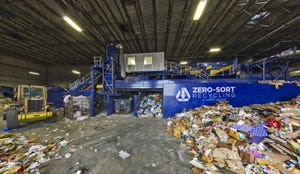RECYCLING: More Energy Expected From Scrap Tire Crop
February 1, 1996
Bill Siuru
Approximately 250 million worn-out tires are discarded each year in the United States, averaging at least one for every member of the American population.
These tire piles accumulating throughout the country can pose some serious hazards, including fires which may result in soil contamination. In addition, landfilled tires filled with rainwater may become breeding grounds for mosquitoes.
Fortunately, ridding the country of scrap tires has captured the nation's attention. Many states have instituted programs to encourage tire recycling, more than 60 percent offering financial incentives.
In fact, all but two states have regulations covering scrap tire disposal. As a result, in Wisconsin, for example, an aggressive waste tire program has disposed of more than 90 percent of that state's used tire inventory.
So far, these measures have achieved positive results. In 1994, for instance, more than half of the 250 million tires discarded were reused. Unfortunately, another 850 million are stockpiled around the nation, according to the Scrap Tire Management Council, Washington, D.C.
Although scrap tires are being turned into park benches, playground equipment, doormats and even clothes, these applications are only a small part of the story.
By far, the greatest number of spent tires are used as fuel. Tires have been a pulp and paper industry fuel source for years and, currently, cement kilns represent the largest scrap tire users.
Other substantial tire consumers are utilities which burn significant quantities as fuel in their power plants. Recently, the Electric Power Research Institute (EPRI) summarized the progress of converting scrap tires to electricity.
In most cases, tires represent a small percentage of fuel burned in boilers, usually less than 10 percent, according to Leslie Lamar in the EPRI Journal.
However, 3 percent of the fuel fed to a 365-milliwatt plant is equivalent to 6 million to 7 million tires. Currently, eight U.S. utilities routinely convert tires to energy; meanwhile, several more are conducting tests and investigating possibilities.
In 1994, 27 million tires, or approximately 11 percent of the 250 million scrap tires were converted to energy, according to the Scrap Tire Management Council. This year, that figure is expected to grow to 52 million or 21 percent.
Tire recycling not only lessens environmental, fire and health problems, but can reduce energy costs as well. Because of its higher heating value, a ton of tires represents about 25 percent more raw energy than a ton of bituminous coal (see chart on page 12).
Compared with many kinds of coal, tires burn more cleanly. Generally containing less nitrogen, tires release fewer nitrous oxide emissions when burned. Also, they leave less ash. Although the metal used in steel belted tires and tire bead wires presents additional disposal problems, these can be overcome with magnetic separation techniques.
Tires also contain less sulfur compared to coal. For example, at Toronto's Ohio Edison, a 42-milliwatt pulverized coal fired plant, nitrous oxides emissions were reduced by 36 percent; particulates by 28 percent; and sulfur dioxide emissions by 14 percent.
The plant burns a mixture of 20 percent tire and 80 percent coal, consuming approximately six tires every minute.
Since 1989, Wisconsin Power & Light Co. has been burning shredded tires in its Rock River plant's six cyclone fired boilers, consuming about 2 million tires annually. More recently, Illinois Power Co.'s Baldwin plant began using shredded tires in two 560-milliwatt cyclone-boilers.
New York State Electric & Gas Corp. started burning shredded tires at its 74-milliwatt Jennison power station in Spring 1991. The station can burn fuel containing up to 25 percent tire chips and, so far, has consumed approximately 2.5 million tires.
In addition, the 415-milliwatt Big Stone power plant in Milbank, S.D., has been using tires as supplemental fuel since 1990.
Some power plants use tires only. For example, a 26-milliwatt tire-burning power plant in Sterling, Conn., uses 10 million tires annually, selling the power to Connecticut Light & Power.
Although tires do not represent an infinite source of energy, they can be an important factor in reducing energy costs. By implementing aggressive programs, refined with state incentives, the benefits of scrap tire recycling could be felt around the country.
You May Also Like


